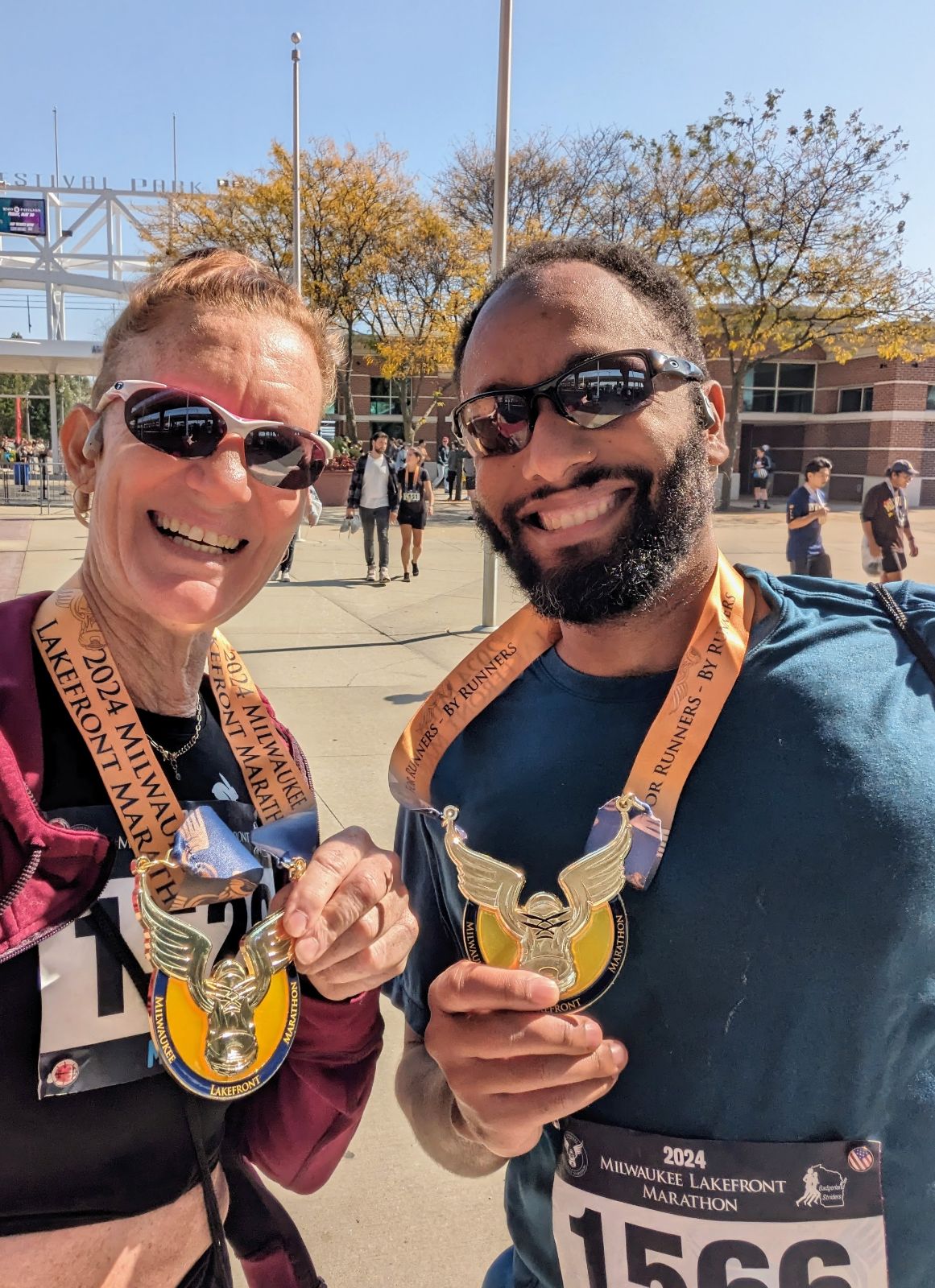Liz Durham, rehab specialist at Cornerstone Health and head coach of Foundational Fitness, just ran the 26.2-mile Milwaukee Lakefront Marathon. Here is her story as told to Dr. J McCrackan, associate chiropractor at Cornerstone.
Dr. J: Well, Liz, you finally did it–congratulations on completing this Herculean task. What made you decide to give it a go?
Liz: Six years ago, I ran the Sugarloaf [in mountainous western Maine], my first and only marathon, and it was really fantastic–a great process, a great race. It hit all the goals one could imagine for a first marathon, so I had no burning desire to run another one–until last year, when I was coaching a lot of runners and immersed in the fun of the extra challenges of running. I started to wonder,
“If I could do so well running a marathon that went up a mountain, what could I do on a mountain-free course?”
By early summer last year, I became incapable of running. A combination of grief over loss and an enduring respiratory issue took running away from me for eight months. As my health improved, I knew that I needed to make a marathon happen this year, a way to regain focus and move forward from what had been an incredibly challenging year.
Dr. J: Back up–tell me about that first marathon, the Sugarloaf. I’d think that anyone’s first marathon would be the hardest to prepare for. How did you decide to try it? How did you train for it? How did you even know how to train for it?
Liz: Sugarloaf Marathon. A friend wouldn’t stop asking me to run it. I kept saying no until I found out there’s an outdoor hot tub at the hotel. Why didn’t she tell me that in the first place!?
To train for Sugarloaf, I followed one of the Hal Higdon training plans for marathons. I was a complete novice at marathons but a highly experienced runner, so I combined features of his Novice and Intermediate plans. And then I listened to my body–you can learn a lot while logging in those long miles.
Dr. J: You say you were “a highly experienced runner.” How so?
Liz: I’ve been running since I was 13 years old, for over 40 years. High school and college were competitive. After that, just running on my own and occasionally doing races. I run because I love running. Races are just like icing on the cake.
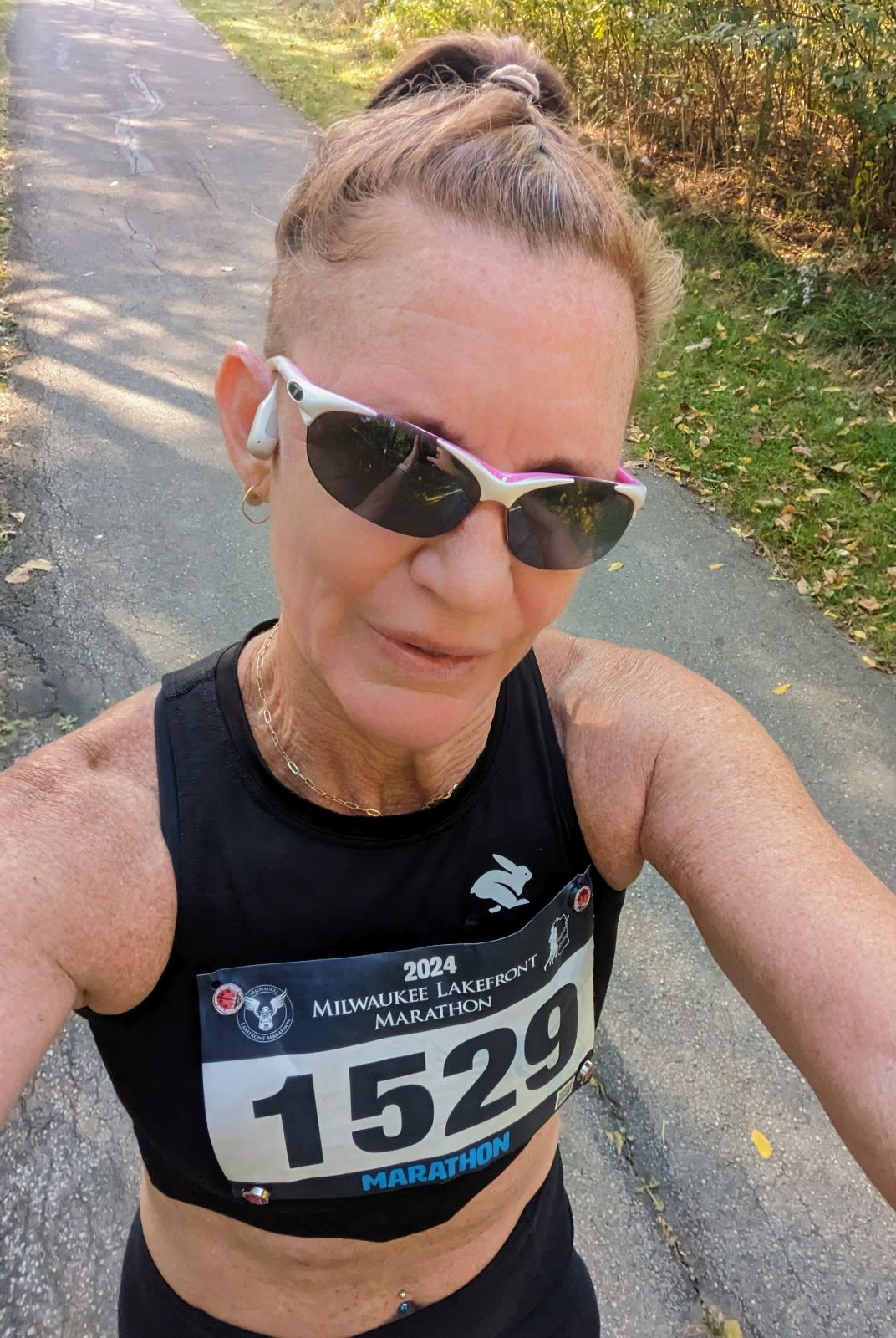
Dr. J: That’s a lot of miles! But you weren’t running marathons–what are your typical runs like?
Liz: When not training for a race, I run anywhere from a 3 to 10 mile run, 3 to 5 days a week. I am less focused on the various types of speedwork when not training and more on maintaining a base and just feeling good through movement. I also strength-train twice a week.
Dr. J: You said that Sugarloaf was “a great process, a great race.” Could you tell us more about what made it a great experience?
Liz: For starters, I was training in winter and early spring. I prefer that kind of weather. Additionally, I find it empowering to create a structure for fitness and to follow through on it. Being able to increase my distance and pace over time is very exciting and rewarding. It speaks to the benefits of consistency, hard work, and dedication. And of course, it simply feels good to run.
Dr. J: Okay, so you were finally in a good place to run a second marathon. But why the one in Milwaukee? Chicago is right next to Evanston; Milwaukee is ninety minutes away.
Liz: Family. My cousin had also been contemplating a marathon, and Milwaukee is halfway between us. We decided it would be great fun to run the same race. Also, the Milwaukee marathon is much smaller than Chicago’s. Milwaukee is predominantly a lakefront race, so I knew it would be beautiful. It twice crosses the Hoan Bridge, and I thought that was pretty cool. I don’t have a desire to run Chicago. So many people, so crowded. I’m not sure I’d be able to find that happy flow feeling in the midst of thousands. On the other hand, if someone dear to me said, “Come on, let’s do it,” I might be willing.
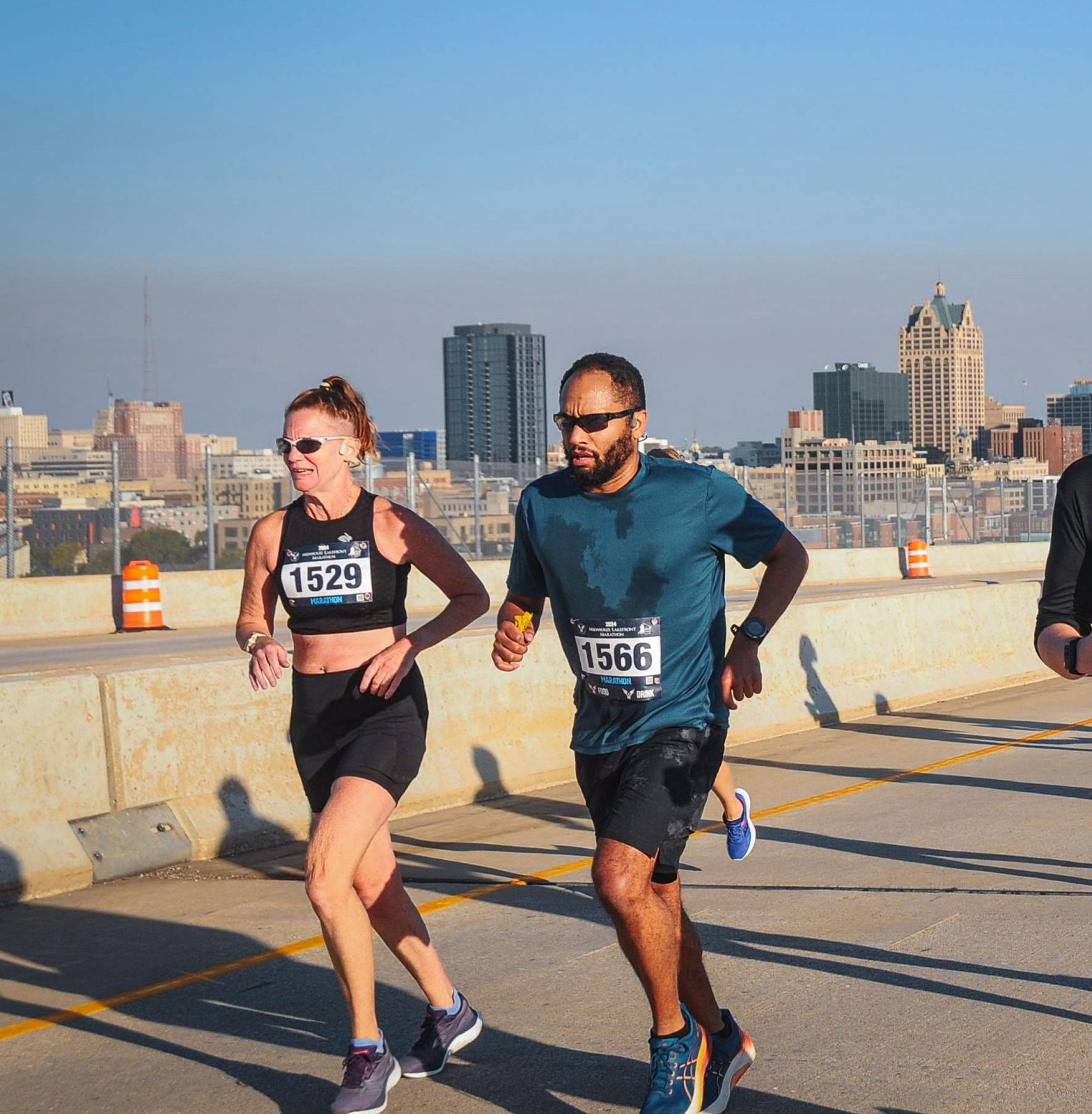
Dr. J: You said that a health issue prevented you from participating in a marathon last year. Didn’t you face a similar challenge this year?
Liz: I am happy to say I had no running injuries during my training. That is very important to note, as injuries are not uncommon during long-distance training. That said, four weeks before race day, I fell while demonstrating a plyometric box exercise. It was a hard fall – brought tears to my eyes. Couldn’t run at all for a couple of days due to incredible pain in my low back. Lucky me, though: working at a chiropractic and physical rehab clinic meant I had immediate resources. (Thanks, Dr. J!) Turns out I sprained my butt and rotated it out of alignment, which made my back seize up. Took me right out of my training. From running 18+ miles, I was now lucky to hit just a few. As if that weren’t bad enough, some cute little play-fighting feline furballs knocked a piece of electronics on my toe just two weeks from race day. That put a screeching halt to all running. So here I am with a left-sided SI sprain and a swollen, bloody toe. Full rest for a week before trying a run/walk. We’ll call it tolerable.
After so much focus on training and preparing, I still felt determined to do the race. I knew I could no longer plan on my original goal. The week immediately prior to the race was all about getting my head okay with the new goal of Finish the Race. I just needed to figure out how to approach the mileage.
Dr. J: So there you were in Milwaukee at 7 AM, about to run 26.2 miles. It had been weeks since you ran half that distance at once. What were you feeling? What was going through your mind?
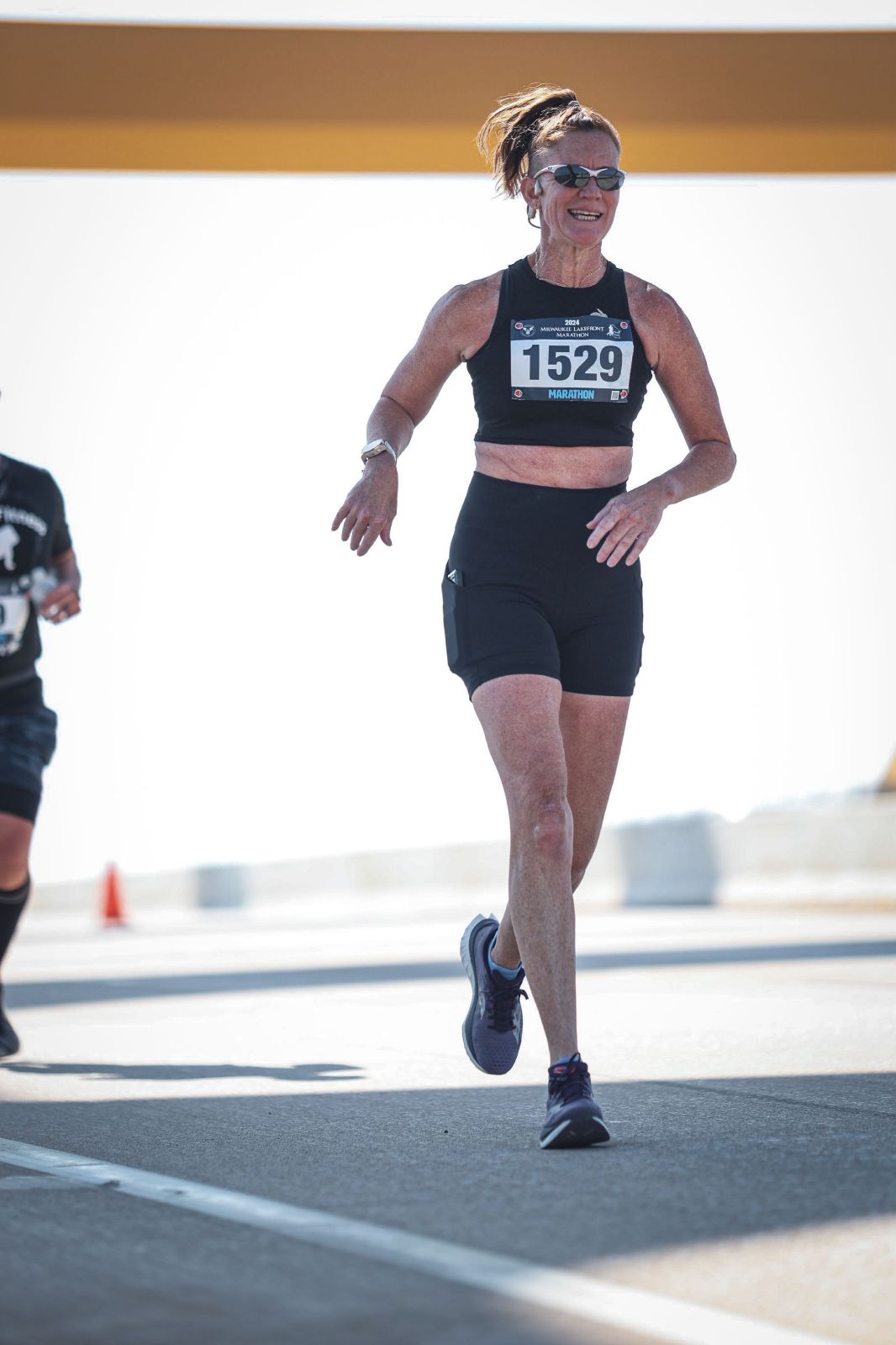
Liz: “Why aren’t there more Portapots??????”I was definitely excited. My cousin and I had a plan to run together as long as possible. We were hoping we could rely on each other to not go out too fast. So after each of the first ten miles, we would laugh a bit as our watches told us we were slightly ahead of pace. It added an extra bit of fun and camaraderie. Obviously, that changed as I pushed past what my injuries were comfortable with.
Dr. J: What was the route itself like?
Liz: Beautiful. We started in the downtown area and made our way a bit north and toward the lakefront. We turned south and ran for quite a few miles with the lakefront just off to the left. At just past mile 7 and then again at mile 24, we reached the Hoan Bridge, which is two miles long. Another stretch was a bit inland from the lake, through residential neighborhoods, and then back to the lakefront. Other than the bridge, the route was mostly flat with just a few little hills.
Dr. J: How far did you get before the discomfort began?
Liz: The toe started whispering to me within the first couple of miles. By mile 5, my toe felt like it was bleeding, as if the bottom of my sock were wet. Turns out it was just the way my brain was interpreting the impact of my stride. The back stuff started a bit later.
Dr. J: I’m sure the discomfort only grew with each step. How did you know when it was time to downshift from running to walking?
Liz: I entered the race pretty sure there would be a downshift. I had decided, though, that I would absolutely run the first half: goal #1. Adrenaline and excitement are quite powerful. By mile 12, I knew for sure I would be walking–and soon. We hit the halfway point, mile 13, still moving at a great pace–goal #1 complete! The shift to run/walk happened around mile 14, just over two hours into the race. It was that unstructured feeling of, “oh crap, I can’t run this,” that became very discouraging. At least my cousin had agreed to keep going–I would’ve felt terrible if he had decided to stick with me. I am definitely not a we-must-run-this-whole-thing-side-by-side type of runner. I am much more of a run-your-own-race person.
Dr. J: So there you were, Liz–having already run thirteen miles, with a nagging toe and aching back, alone, depleted of both adrenaline and excitement, and another twelve miles to go. How did you manage to rally to complete the marathon?
Liz: After a mile or two of being way too much in my head, discouraged and not able to minimize the toe and back, I knew I had to do something to pull myself together. I needed a strategy. A new process. A goal. I began to run at least 0.8 and walk no more than 0.2. [That is, I ran 80% of every mile and walked 20%.] I walked with intention and let those distances switch as needed: run/walk became walk/run became walk, with the occasional twenty-second run. Walking with speed and intention–I definitely hadn’t trained for that, and it was challenging!
Dr. J: But you did it. Somehow, you dragged yourself across that finish line. What did that feel like?
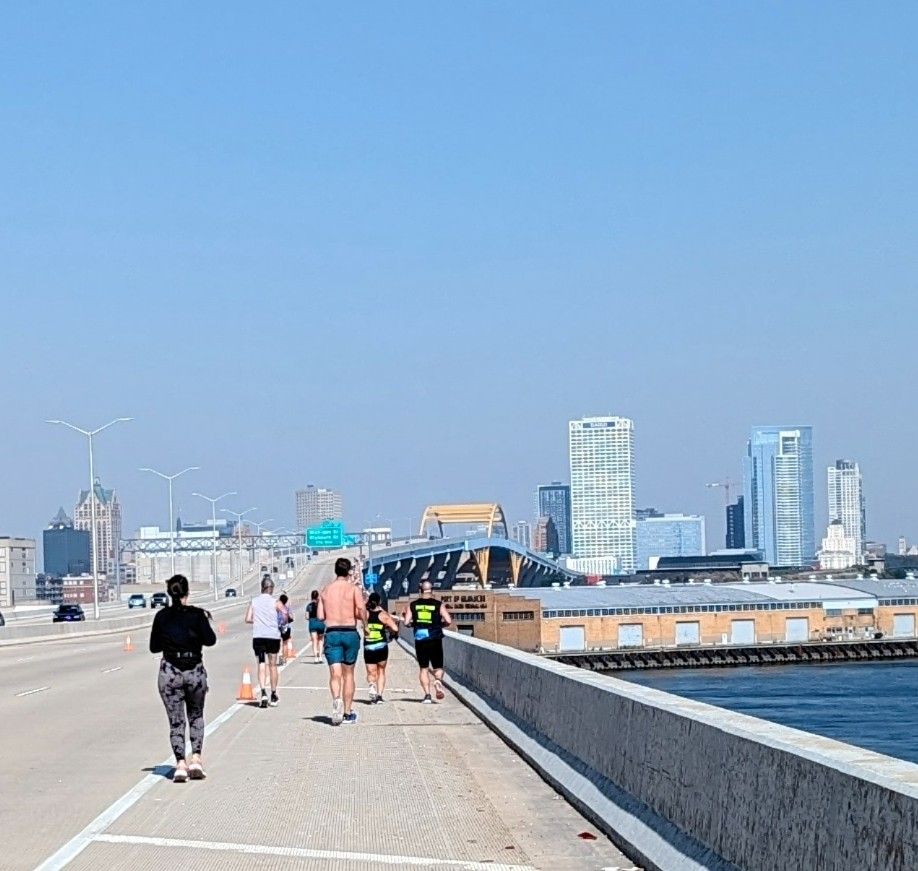
Liz: Miles 24-26 was the Hoan Bridge, the longest two miles of the race. Come off the bridge, turn right. Final 0.2 miles is basically the chute to the finish line, where the crowds of people were, all cheering and whooping. No way was I going to walk; no way did I want to run. So I ran. Of course I ran. And tried to look happy about it. I saw my cousin cheer me on, and that was fun. And I finally crossed the finish line. Goal met! Finished the race. I was so happy to cross that line. It was not the race I had planned back in June when I started training for it, but I ran well for the running portion. And I listened to my body.
My cousin had run a solid race–“my race,” so to speak–and we were pleased with how we both did, all things considered. We sat for a bit, ate post-race snacks. I took off my running shoes. And then we walked over a mile to get back to the hotel.
Dr. J: When I complete projects in which I’d been fully immersed, I often feel a bit melancholy, not knowing what to do with myself. Is there anything like that with marathons, or are you just relieved when they’re over so that you can get on with the rest of your life?
Liz: Oooooo, I like this question. It dives right into how to manage focus and what I call “the feels.” Of course, all running is about the combination of those two things, at least for me. Running provides mental stimulation and focus in the planning, organizing, and strategizing. It also provides all sorts of feelings, the physicality of it, the ability to let go of thoughts and find that feeling of flow. It’s magical.
“Melancholy”? Not a bit. With Milwaukee behind me, I know exactly what to do with myself: find another race. Create a new training plan. Build endurance. Build strength. In the near future, my next race will be shorter, but I have not yet decided which one. Maybe a 10K, as I rarely do those, or a 5K to work on speed.
“Relieved that it’s over”–now, that sounds like something a non-runner would say, as if it were an ordeal to get through. I enjoy the process of training and running. Bodies are built to move, and I feel best mentally and physically when I can move. I am, however, relieved that the days of 90° weather and high humidity are over!

Ready for Liz to help you find your strength? Contact us and schedule your free no-stress consultation today.
Dr. J. McCrackan
Contact Me